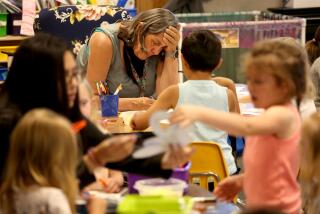Paring Class Size Costly, Futile, U.S. Report Says
WASHINGTON — Reducing class size in public schools is very expensive and probably “a waste of money and effort” for those seeking improved student achievement, according to a study issued Wednesday by the U.S. Department of Education.
There now are 24 students in the typical American public elementary school classroom. In California, the average is 28.
Research has indicated that classes would have to be reduced to 15 students to have any appreciable impact on student performance, the study said.
But that would cost upward of $69 billion and require the hiring of 1 million new teachers at a time when schools already are having difficulty filling faculty vacancies, according to Tommy M. Tomlinson of the department’s Office of Educational Research and Improvement.
Workload Lighter
“If teachers today believe that the number of students per class is too large and their workload too heavy, it is also true that the number of students they teach has never been fewer and . . . their workload has never been lighter,” said his report, “Class Size and Public Policy: Politics and Panaceas.”
Efforts to boost student test scores through smaller classes “will probably be a waste of money and effort,” the report said.
California Supt. of Public Instruction Bill Honig said the federal study rightly raises the issue of whether limited funds should be spent to reduce class size but that, he said, does not mean that the goal of smaller classes should be dropped. Fewer students in a class means more individual attention from teachers, he said in a telephone interview, adding: “If it doesn’t make a difference, then why do so many parents put their kids in private schools where smaller classes are usually the draw?”
In Washington, Chester E. Finn Jr., assistant secretary of education in charge of research, said in an interview that lowering class size has become “an ersatz reform goal around the country.”
Not a Prudent Investment
“There are a lot of better and less costly things you can do and get results,” Finn said. “There’s no question that good teachers in tiny classes are one of the reasons people pay for expensive private schools. But it’s not a very prudent investment strategy if you’re trying to improve the vast enterprise of American education.”
Reducing class size is not a major goal for the Los Angeles Unified School District, according to spokesman Bill Rivera, who said the district is struggling just to build enough new schools to keep class size from increasing. Rivera said classes average 32.5 students in schools with minority enrollments of more than 60% and 27 students in schools that are at least 60% Anglo. No districtwide figures are available, he said.
The federal report says teachers have clamored for smaller classes for decades, and whenever they achieve their desired goal, they set a still smaller one.
“It’s never small enough,” Finn said.
The National Education Assn., the 1.85-million-member teachers union, has a policy that states that “excellence in the classroom can best be attained by small class size,” and it urges affiliates to “seek an optimum class size of 15 students.”
Used as Rationale
Keith Geiger, the NEA’s vice president, said in an interview: “It is very expensive to lower it to 15, but they continually use this rationale for doing nothing. We have elementary teachers out there sitting with 38, 40, 42 kids in their class. That’s the sad part.”
He said outsized classes are particularly common in California.
“I’m not going to give up on all the other grades,” Geiger said, “but we’ve got to move to less than 20-to-1 in the early elementary grades if we’re ever going to expect to reach these kids so we don’t have to spend all the money on remediation when they get into junior and senior high school.”
The report said that “unless the number of pupils per class is reduced substantially below 20--at least to 15 according to one . . . research review--little improvement in student achievement may be expected.”
It claimed that reducing class size “is inconsistent with the push to enhance teacher professionalism,” and suggested that “rather than sink vast sums into an inefficient and unreliable method of school improvement, available resources should instead be directed to improving the quality of instruction and teachers’ ability to manage the demands of classrooms as they are currently configured.”
A Focal Point
Several states have made smaller classes a focal point of their school reform efforts. Indiana Gov. Robert Orr persuaded his state’s legislature to raise the sales tax to pay for a program of limiting kindergarten and first-grade classes to 18 children and grades 2 and 3 to 20 children. The cost in the first two years was $114 million.
The report says that reducing the size of the typical class from 24 to 23 pupils would require 73,000 more teachers and cost $5 billion, “not counting the expenses of building more classrooms.” A reduction to 20 students would require 335,000 new teachers and cost $22.8 billion, it says.
More to Read
Sign up for Essential California
The most important California stories and recommendations in your inbox every morning.
You may occasionally receive promotional content from the Los Angeles Times.










